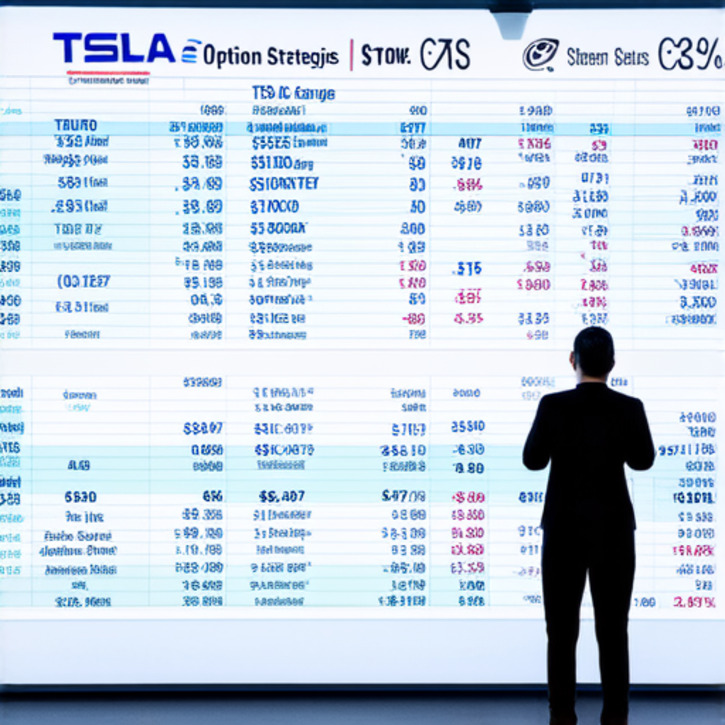TSLA Option vs. Other Stock Options: What Investors Need to Know

TSLA Options vs. Other Stock Options: What Every Investor Should Know
Kicking Things Off: The TSLA Options Scene
Lately, TSLA options have been buzzing in the investment world, drawing interest with their one-of-a-kind vibe and impressive growth story. As more traders dive into TSLA options, people are keen to see how these instruments might fit into a broader investment approach. Unlike your run-of-the-mill stocks, TSLA options bring an extra dash of volatility and the chance for sky-high rewards – a mix that’s as fascinating as it is a bit tricky. In this post, we’re breaking down what makes these options tick, blending solid research with down-to-earth insights to help you feel ready to jump into this fast-evolving market.
With market moods shifting on a dime, TSLA options have earned a reputation as a lively, ever-changing tool in any portfolio. They attract everything from seasoned pros to big institutional players, all eager to ride the wave of Tesla’s rapid innovations in the electric vehicle space. The trends driving TSLA options often mirror broader shifts in technology and market sentiment, making them a kind of early-warning system for innovation-heavy stocks. Throughout this discussion, we’ll compare TSLA strategies with more traditional stock options, highlighting both the similarities and the crucial differences. Whether you’re just starting out in options or looking to spice up your portfolio, getting the hang of TSLA options could really set you apart.
In short, trading TSLA options isn’t just about betting on Tesla’s performance – it’s about catching the beat of technology and innovation. With Tesla leading the charge in the electric vehicle revolution, its options come with both excitement and the challenge of managing risk. This unique mix makes TSLA options an enticing choice for a diversified portfolio, marrying the thrill of tech investments with the strategic depth of the options world. In this article, we’ll dive into the basics of TSLA options, contrast them with more traditional stock options, and shed light on the strategies savvy investors use to navigate this dynamic landscape.
A Look at the Latest TSLA Options Trends
Over time, the TSLA options landscape has shifted a lot, echoing changes in the broader market and Tesla’s own rapid progress. Investors have noticed that these options can swing wildly, especially around company news, new products, or shifts in market sentiment. Market watchers really keep an eye on these movements, as Tesla’s business style often sparks dramatic price shifts. Figuring out these trends doesn’t just help you make smart moves – it also shows just how intertwined TSLA options are with overall market vibes.
The way TSLA options behave tells an interesting story about investor psychology. As Tesla keeps shaking up the auto industry and more, its options become a sort of barometer for market optimism and risk appetite. While traditional stocks tend to move more steadily, TSLA options can deliver big payoffs – along with equally big risks. Whether you’re a die-hard fan or a cautious skeptic, watching TSLA options is like sitting at the pulse of the market, where every new development sends ripples through both option prices and the wider stock indices.
Why TSLA Options Are a Standout Investment Tool
What really makes TSLA options special is their deep connection to one of the world’s most dynamic companies. With Tesla making bold moves across electric vehicles, renewable energy, and more, these options capture a level of complexity that many investors find both challenging and rewarding. It’s not just about impressive market performance; it’s Tesla’s innovative business approach that really colors how these options are priced and perceived.
Unlike many options tied to more traditional companies, TSLA options tend to invite a fair bit of speculation, attracting everyone from veteran day traders to those just looking to play the volatility card. The tug-of-war between the high potential rewards and the substantial risks gets reflected in price swings that mirror both Tesla’s rapid evolution and the broader tech innovation landscape. For investors, keeping a close watch on TSLA options can offer insights into wider market movements that might not be as apparent with other stocks.
Putting TSLA Options Head-to-Head with Traditional Stock Options
When you stack TSLA options against other stock options, the differences really stand out, mainly because of the underlying company’s business model and market performance. While traditional options typically relate to companies with steady and predictable earnings, TSLA options are heavily swayed by tech innovation, market disruption, and even regulatory changes. This mix often leads to more dramatic volatility in the TSLA sphere, where news events or shifts in technological sentiment can cause rapid price changes.
Unlike conventional stock options, trading TSLA options demands a fresh analytical perspective – one that takes into account both the detailed inner workings of Tesla and the broader tech trends at play. What works for traditional options doesn’t always cut it in the TSLA world, where public sentiment and innovation milestones can heavily influence every trade. Up next, we’ll walk you through the basics, arming you with the insight you need to navigate this complex market.
Breaking Down the Basics of TSLA Options
So, What Exactly Is a TSLA Option?
Simply put, a TSLA option is a derivative that gives you the right – but not the obligation – to buy or sell Tesla shares at a set price within a specific period. This kind of flexibility makes TSLA options really appealing to traders who want to take advantage of short-term price moves while still playing the long game on Tesla’s performance. By using these options, investors can boost their exposure to the market even if they aren’t throwing a ton of capital into the mix.
Essentially, TSLA options serve as a smart tool for hedging risk or speculating on future price swings of one of the market’s hottest companies. They’re not just a bet on Tesla’s stock – they’re also a way to manage risk with well-planned positions. If you’re new to trading or have been around the block a few times, understanding TSLA options is key, as it sets the stage for building more advanced strategies. It’s this inherent flexibility that really makes these options stand out in the options market.
The Nuts and Bolts of TSLA Options Trading
Trading TSLA options involves juggling a few key components – knowing your strike price, keeping track of that expiration date, and figuring out the premium cost, among other things. The strike price is essentially the price at which you can exercise the option, while the expiration date marks its end. Then there’s the premium – the fee you pay for the option – plus the pretty important intrinsic versus extrinsic values that come into play when setting its market price. For many investors, getting to grips with these elements is a crucial first step toward using TSLA options effectively.
Although TSLA options share similarities with traditional options, they require a bit of extra nuance thanks to Tesla’s characteristic volatility and growth pace. In fast-moving markets, sometimes you’ve got to take a bit of a leap of faith – and timing and sentiment really do matter here. This means you need a good understanding of both Tesla as a company and the market forces that drive option prices. In short, it’s all about staying flexible and updating your strategies as Tesla and the broader market evolve.
Diving Into the Different Types of TSLA Options
At its core, there are two main types of TSLA options: call options and put options. Call options give you the right to buy Tesla shares at a predetermined price, making them a favorite among investors who are bullish on Tesla’s future. On the flip side, put options let you sell Tesla shares at a set price, often serving as a kind of insurance policy if you’re worried about a downturn.
Beyond these basics, traders sometimes explore more creative strategies like spreads, straddles, and strangles to manage risk while positioning for major market moves. With such a variety of TSLA option types available, you have the flexibility to build a strategy that matches your risk tolerance and market outlook. Knowing your options inside and out is key to tailoring a strategy that fits whether you lean toward a more conservative hedge or prefer aggressive speculation.
TSLA Options Versus Traditional Stock Options: The Main Differences
Risk and Reward: How TSLA Options Stack Up
One of the big differentiators between TSLA options and more traditional stock options is their risk and reward profile. TSLA options can deliver hefty rewards thanks to the volatility stemming from Tesla’s innovative business model; however, these rewards come with a higher degree of risk. The same dramatic price swings that can lead to big gains might also result in swift losses if the market mood changes in a heartbeat.
Traditional stock options, in contrast, often belong to companies with more stable operations, producing more predictable risk and reward profiles. This means that if you’re leaning toward TSLA options, you’ll need a more dynamic risk management game plan – one that carefully weighs both intrinsic and extrinsic factors driving the volatility. Essentially, while the promise of high returns makes TSLA options very enticing, you’ve got to be ready for the ride.
Liquidity and Volatility: A Delicate Balance
In the world of TSLA options, liquidity and volatility are two sides of the same coin. Liquidity determines how smoothly you can get in and out of your positions without causing major market ripples. In TSLA options, you often get an exciting mix of high liquidity paired with intense volatility. This combination can be a double-edged sword – attracting those who thrive on fast markets, but possibly deterring anyone who prefers a more stable, controlled environment.
When you compare this with traditional stock options, you’ll typically find that they enjoy lower volatility and more predictable liquidity. That contrast underscores the idea that while TSLA options might offer explosive returns, they demand a high level of agility and responsiveness to market changes. Paying close attention to liquidity and the natural ups and downs is crucial if you’re considering adding TSLA options to your investment toolbox.
How Market Mood Shapes TSLA Option Pricing
Market sentiment plays a huge role in pricing TSLA options. Investor moods, spurred on by news, technological breakthroughs, and broader economic trends, can sway option premiums in big ways. In the fast-paced world of tech and innovation, prices often reflect not just the hard numbers but also the overall market vibe. This blend of concrete data and market sentiment is what differentiates TSLA options from more traditional options.
For example, a strong earnings report or a leap forward in battery tech can quickly bump up the premiums on call options, as traders get excited about future growth. On the flip side, any negative news or regulatory hiccups can drag those prices down fast. Keeping your finger on the pulse of what’s driving public sentiment can give you a real edge – both in the TSLA options market and in understanding broader market trends. It’s an essential part of crafting any solid trading strategy.
Navigating TSLA Option Pricing and Valuation
Pricing Models: Finding the Right Fit for TSLA Options
When it comes to valuing options, the pricing model you choose is key – and TSLA options are no exception. Many traders lean on the tried-and-true Black-Scholes model, which has long been a staple for pricing European-style options. That said, because TSLA can be so volatile, sometimes adjustments are in order. The Binomial model is another popular choice, thanks to its flexibility in accounting for various market conditions and features like early exercise.
Every pricing model comes with its set of assumptions and trade-offs. Diving deep into these models can help you pick the right strategy for the moment. With TSLA options, where rapid and steep price moves are the norm, relying on just one model might not give you the full picture. Instead, blending insights from multiple valuation approaches can create a more rounded view, helping you figure out if the premium on a TSLA option is really justified by both the numbers and the current market mood.
Getting a Handle on Implied Volatility
Implied volatility is probably one of the hottest factors in valuing TSLA options. It’s essentially the market’s forecast of how much a stock is likely to move, and it plays a crucial role in setting the premium on an option. Since TSLA options tend to see higher volatility than traditional stocks, keeping an eye on implied volatility is absolutely vital. Even if Tesla’s stock price holds steady, a spike in implied volatility can push option prices up, reflecting an overall sense of uncertainty.
Savvy traders use implied volatility not just to gauge potential risk, but also as an early indicator of mood shifts in the market. In the context of TSLA options, sudden changes in this metric can suggest upcoming events or increased uncertainty. Combining insights from implied volatility with other valuation techniques can help you nail down more precise entry and exit points. Mastering this concept is key if you want to capitalize on the rapid, dramatic moves that define the TSLA options arena.
How Valuation Strategies for TSLA Options Compare
When you put valuation strategies for TSLA options side by side with those for traditional stock options, the differences really pop. For many conventional stocks with lower volatility, standard models like Black-Scholes often do the trick without too much tweaking. But in the TSLA context, you need a more flexible, nuanced approach. Many traders blend quantitative models with qualitative market observation to zero in on a more accurate valuation.
This hybrid approach, combining solid math with sharp market instincts, shows just how important it is to stay adaptable. While traditional stock options might follow more predictable trends, TSLA options demand a nimble strategy that can shift in real-time with market conditions. The key is understanding the strengths and limitations of each valuation technique and aligning your strategy with both the big picture and your personal risk profile.
Weighing the Risks and Benefits of TSLA Options
Why Adding TSLA Options to Your Portfolio Could Pay Off
One of the biggest perks of including TSLA options in your portfolio is the chance to use high leverage without breaking the bank. These instruments let you control a sizable chunk of Tesla stock for a relatively modest investment. That means you can potentially reap substantial rewards without committing too much capital—as long as you’re comfortable with the inherent ups and downs.

Laura Henderson is an enthusiast and has been writing on cutting-edge topics for years.







